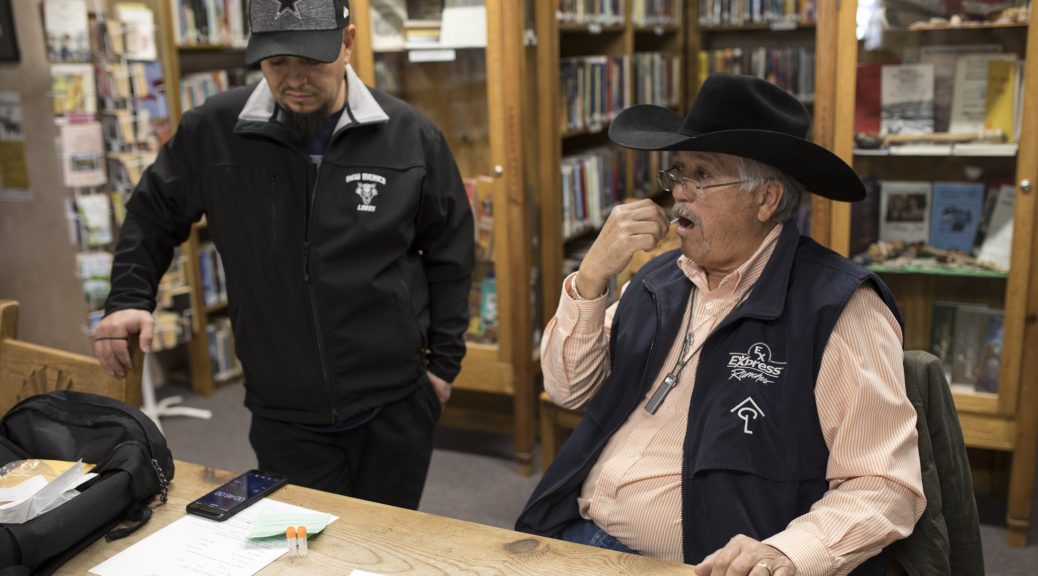
Recovering Ancestral DNA in Abiquiú
As a genetic genealogist, much of my work is done behind a computer screen or amidst a stack of books. In the Fall of 2017, I was invited by Isabel W. Trujillo, the Pueblo de Abiquiú Library and Cultural Center Director, to assist her in conducting work related to a group of Abiquiú community members with long standing genealogical and historical ties to the Pueblo of Abiquiú who also identify as genízaro or genízaro descendants. As defined by Fr. Angelico Chávez, genízaro was the designation given to North American Indians of mixed tribal derivation living among the Hispanic population in Spanish fashion: that is, having Spanish surnames from their masters, Christian names through baptism, speaking a simple form of Spanish, and living together or sprinkled among the Hispanic towns and ranchos. The Library was granted funds for this effort from the Northern Rio Grande National Heritage Area, which the New Mexico Genealogical Society was able to match. Moises Gonzales with the Center for Regional Studies UNM was recruited to assist and provided his ethnographic expertise to the project.
The goal of the project was to offer insight into the historical and contemporary context of the genízaro. This identification was accomplished by using triangulation of genealogies—DNA—and cultural performance. During the process, we also conducted many personal interviews, which allowed us to hear stories about community kinship and knowledge directly from participants. The project consisted of a total of twenty participants, ten males and ten females. Twenty participants represent approximately 10% of the community population.
The process for this project consisted of:
- Interviews of contemporary people with connections to the Pueblo de Abiquiú.
- Subjects were verified to not be immediately related to assure that identical lineages, both Y-DNA (direct paternal) and mtDNA (direct maternal) were not being duplicated.
- Y-DNA37, mtDNA Full Sequence, and Family Finder (atDNA or autosomal) tests were conducted on ten male participants.
- mtDNA Full Sequence and Family Finder (atDNA or autosomal) tests were conducted on ten female participants.
- Genealogical investigation of male participants direct Y-DNA and mtDNA lineages as far back as possible.
- Genealogical investigation of male participants on all branches developing a 5-generation pedigree.
- Genealogical investigation of female participants direct mtDNA lineage as far back as possible.
- Genealogical investigation of female participants on all branches developing a 5-generation pedigree.
- All DNA testing done by Family Tree DNA and data managed in the New Mexico Genealogical Society’s DNA Project (NMGS DNA Project).
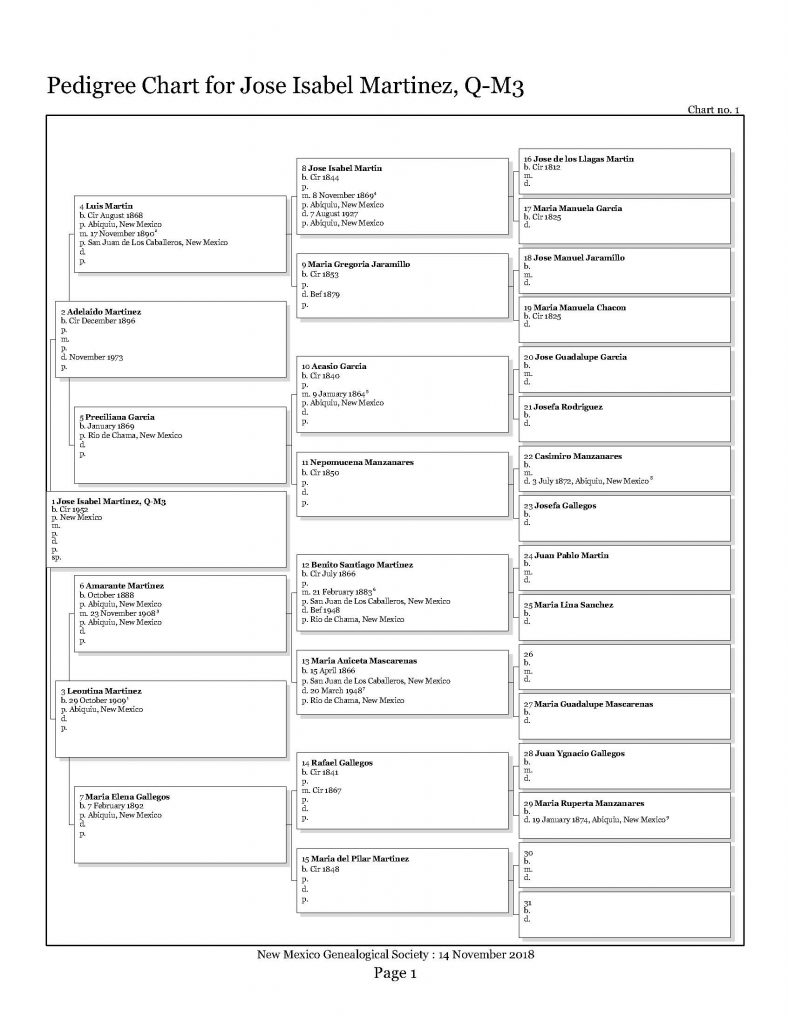
Based on interviews of all the participants, the Pueblo of Abiquiú has a deep and interwoven network of self-recognition and kinship through extended family relationships. Family surnames such as Suazo, Martínez, López, Trujillo, García, Archuleta, to name a few,are connected through hundreds of years of intermarriage among the original Hopi-Tewa people that organized the Pueblo de Moqui as well as the genízaros of Ute, Apache, and Navajo background that were raised in the Pueblo of Santo Tomás (Gonzales).
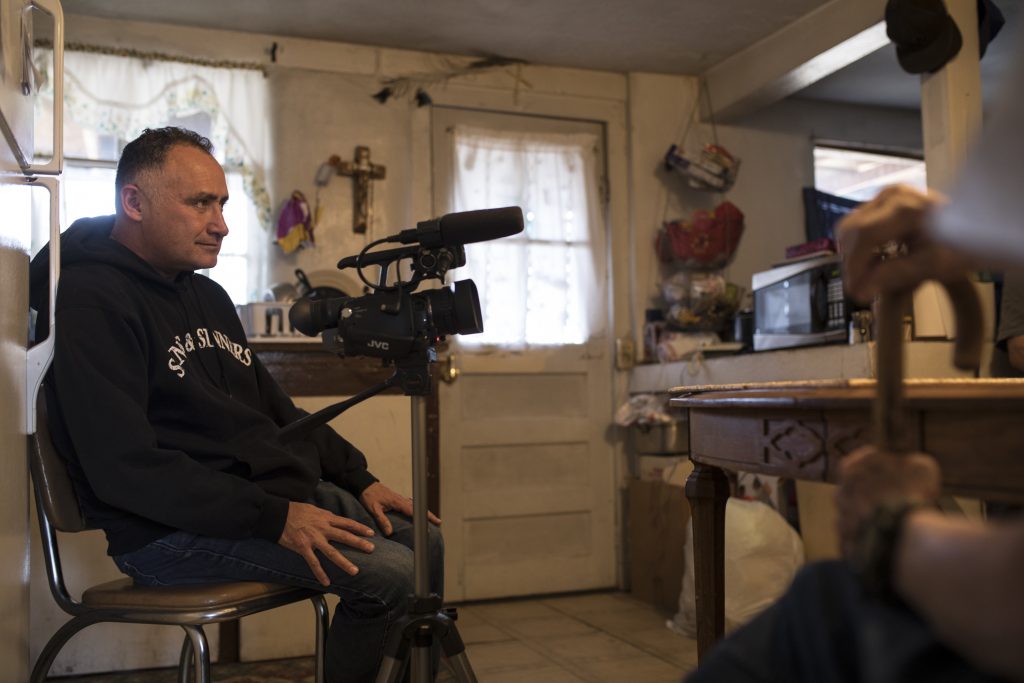
The genealogical data not only confirmed a long history for the majority of the participants in the Pueblo but also supported the historical knowledge that Abiquiú in the 18thcentury was also settled by migrations from communities such as Santa Cruz de la Cañada and San Jose de Chama. The genealogy and DNA made links to families from all regions of New Mexico and southern Colorado, supporting an outward migration in the latter part of the 19thcentury to communities such as Chama, Taos, Questa, and many in southern Colorado. One of the Y-DNA male line lineages investigated resulted in a male paternal Y-DNA linked to a Naranjo family with early 1700 roots in Santa Clara. One of the female participants told of her grandmother’s connection to Santo Domingo Pueblo which genealogy research later confirmed and mtDNA confirmed a direct Native foremother link.
The objective of the oral interviews was to understand how genízaros at the Pueblo de Abiquiú have created a sense of kinship and self-recognition since the time of their ethnogenesis in the 18thcentury up to contemporary times. Modern scholars of ethnography, especially those rooted in critical indigenous studies, argue that archival records and DNA alone do not prove Native American ancestry, rather, the collective experience and knowledge shared over time by a native group is what creates Native American kinship and tribal belonging. (Gonzales).
The statistical data provided by DNA testing confirms that Native American roots for all participants exist at varying levels. The study concluded that the three elements of our research, interviews and DNA testing of men and women, cement what the people of the Pueblo de Abiquiú inferred about themselves–the genízaro culture is alive and well at Abiquiú.
The interviews and DNA testing for most were conducted at the Abiquiú library. For many, the library is adorned with pictures of their ancestors, creating an atmosphere like a grandmother’s home. Many pointed to the pictures and proudly proclaimed their relationship. Witnessing the excitement and joy from participants upon receiving their DNA and genetic ties confirmed that the efforts of this type of work at the community level is not only important to the individual but confirms that it benefits cultural preservation and participation.
The full report of this project will be featured in the March 2019 New Mexico Genealogist. This work was also featured in New York Times January 18, 2018, and in the Albuquerque Journal, January 13, 2019.
Indian Slavery Once Thrived in New Mexico. Latinos Are Finding Family Ties to It.
https://www.nytimes.com/2018/01/28/us/indian-slaves-genizaros.html
Results of DNA project in Abqiuiú support oral history of Native history.
https://www.abqjournal.com/1267368
New Mexico Genealogist.
https://www.nmgs.org/about-nmg-journal
Featured Photo at the top: Miguel A. Tórrez and Gabriel John Lopez conducting DNA testing. ( Photo courtesy of Adria Malcolm).
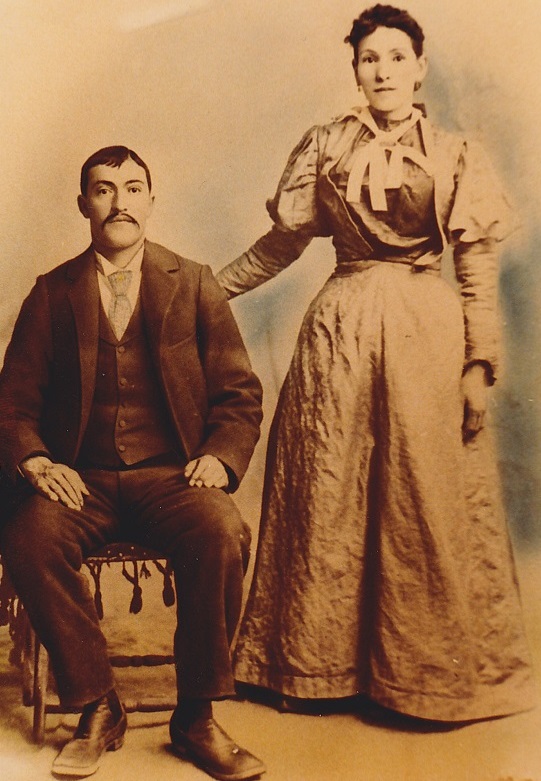
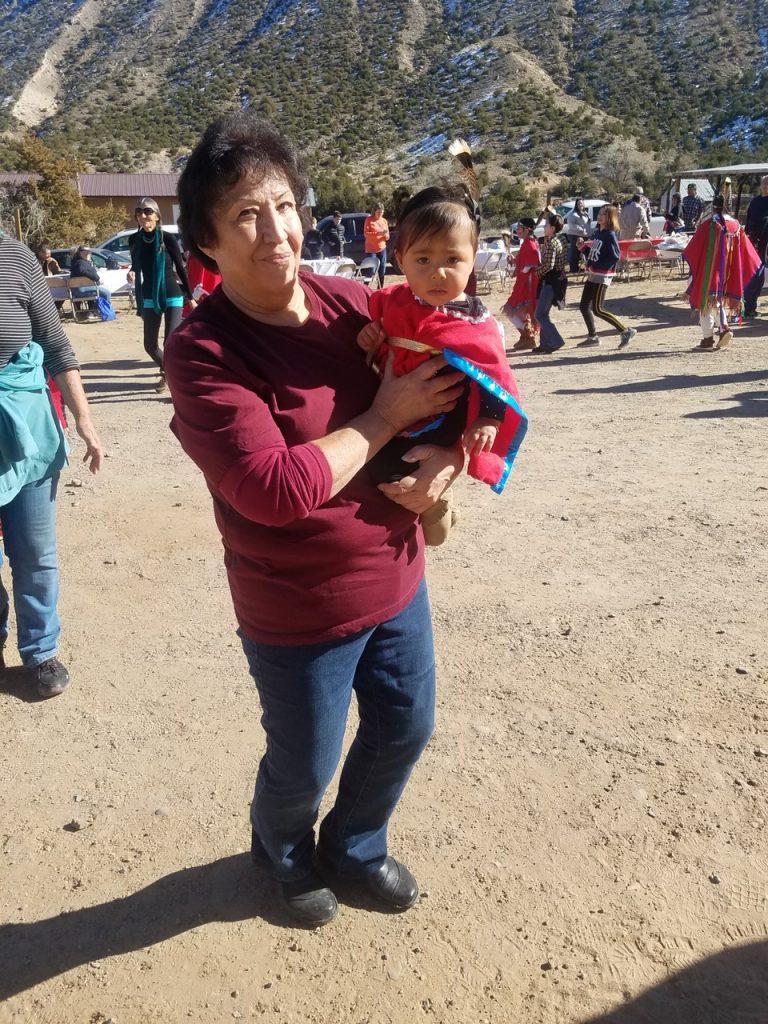
23 thoughts on “Recovering Ancestral DNA in Abiquiú”
Very nicely put together. Happy with the results!
my ancestors came from Abiquiú. My Great Grandmother was Lugarda Gonzales, her parents were Reyes Gonzales and Teofila M Gallegos.
My parents were born in Abiquiu as were their parents my father Bennie Gallegos his Father Fermin Gallegos his father Reginald’s Gallegos
My Trinidad Archuleta father Masiminio Archuleta
My grandfather on my moms side was from Abiquiu, Pete Trujillo. I did his oldest sons dna and my dna. And my dads DNA which is not the same side of my moms family who came from Abiquiu.
I lived in Abiquiu from 1947 to 1955. My grandparents were Gabriel and Gregorita Lopez I lived with them until we moved to California. I know many of the older people and know I have lots of relatives who still live in Abiquiu.
My mother was raised in San Luis Colo. she was a Sanchez, her mother was a Rodriguez, I traced the Rodriguez family to the year 1766 I was told they came from Santa Cruse New Mexico, and came there with the Don Diego de Vargas expedition, I did a DNA, with 23 and me and found out that I’am 30% native american, I would like to find out what tribe of native american I come from, can anyone help me .
Hola Manito,
I have ancestors from Abiqui. Starting with Juan DD Trujillo in down to María Dolores Valdés 1827. So exiting to do my DNA to find I have 42% Native American from Northern New Mexico/Southern Colorado. I purchased Y-DNA for my oldest brother to do.
My grandparents were Jose Pablo J P Gonzales and Anita Gonzales (Garcia). G Grandfather was Tomas Gonzales, GG Reyes Gonzales, and my mother’s name was Mary Sandoval (Gonzales), were all from Abiquiu. My grandmother’s maiden name was Anita Garcia, married to Jose Pablo Gonzales, I believe Reyes Gonzales was married to a Gallegos from Abiquiu, as well. I am on Facebook friend with Moises Gonzales, along with brother Ronnie, Ernest, Edward and James Sandoval.
That is my brother only male from juan d lopez. I am carmen lopez jones reside in utah this was thebest job i have seen i have also done my dna. Have a family tree too love all the hard work
My paternal grandmother’s maternal grandmother María Agapita Chávez was born in March 1852 at Abiquíu. How can I submit a DNA sample for testing to check for Native American ancestry?
Thank you for your great work! We have Romero, Duran lineage from Abiquiu! Please let me know if we can participate.
I was hoping that you could steer me in the right direction to find my ancestral relation from my grandmother, Frances Fisher, whose father was George Fisher or Norberto Fisher. Their father was Robert Fisher married to Maria Rumaldo Lopez born in 1820 and the notes indicate that she is from the Abiquiu Pueblo. I also suspect that she may have been “indentured” from oral history. Thank you
Good Morning,
I am a great grandson of Robert Fisher and Maria R. Lopes (Lopez).
If you are still seeking information, I may have some to share.
Be safe, Be well
Virginia,
I am descended from Robert Fisher and will be more than happy to share whatever info I can with you. Rumalda was born in Abiquiu and I, finally, was able to locate her baptismal record from a recently published Santo Tomas Baptism book. You can reach me at annaleyba at gmail.
Why can’t you printl T-shirts that say something
like ” Jenizro culture of Abiquiu ” .
I would buy at least two!
why was our name changed from Martin to
Martinez .
I’ve read that an Abiquiu family had a tradition of naming all first born sons Martin. After some generations with a lot of cousins named Martin, the group started being referred to as Martinez.
I would love to know if this is really the story of how Martinez became a common last name in New Mexico.
I have heard that Martinez with ez at
End is Jewish while Martines with es
Is Spanish!
There is both Martin and Martinez or es
In Spain! Can you check this out?
the old records show that my great grandfather’s last name was Martin and the Church
changed it when they baptized my grandfather!
Could you accommodate 20 people for group study and tour? Sept. 23, 2023. We have a family reunion that focuses on geneaology in the area, including Abiquiqi.
Apologies for the late reply! Have you been able to arrange a tour for your group?
I wrote a letter to Deb Holand department of the interior about recognizing
Genizeros of Abiquiu as indigeanous people . The state already has recognized them
but that doesn’t mean anything. It has to be done by Federal Government. There are
many individuals in Abiquiu and surrounding area that are decendents of Genizero
Indians.
You should sell T-shirts with the insignias
Genizero Pride !!!!